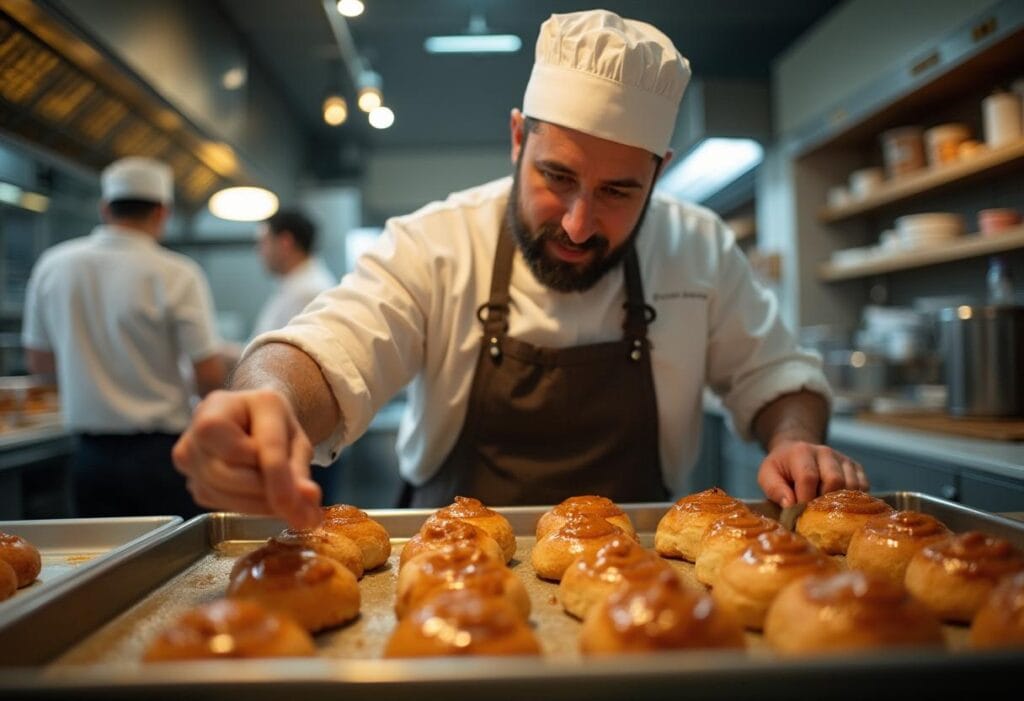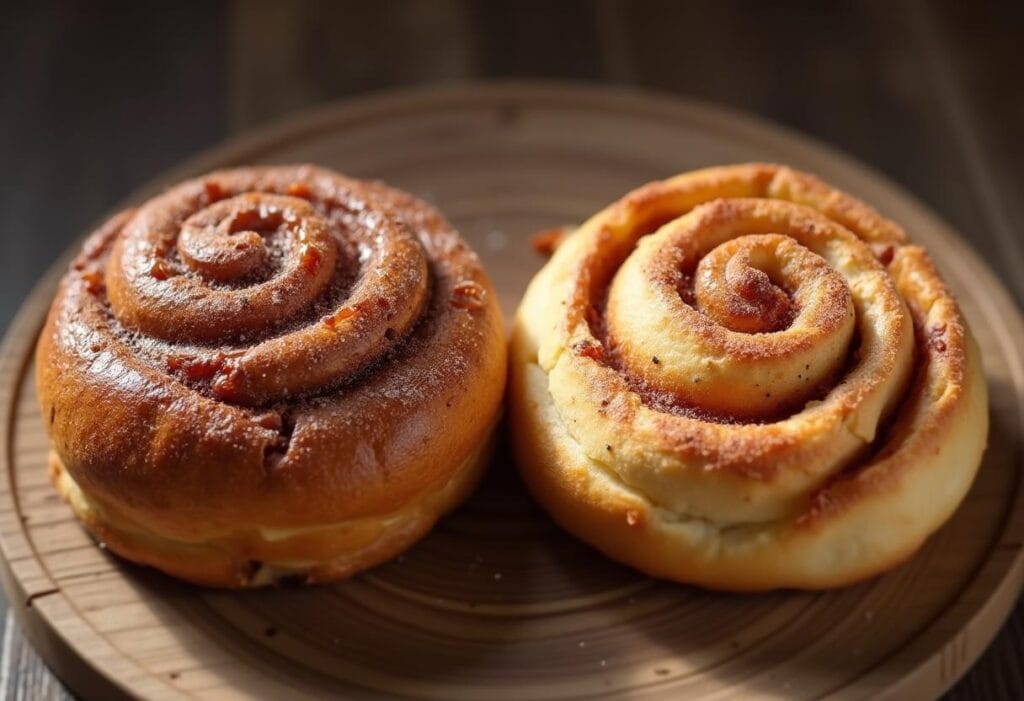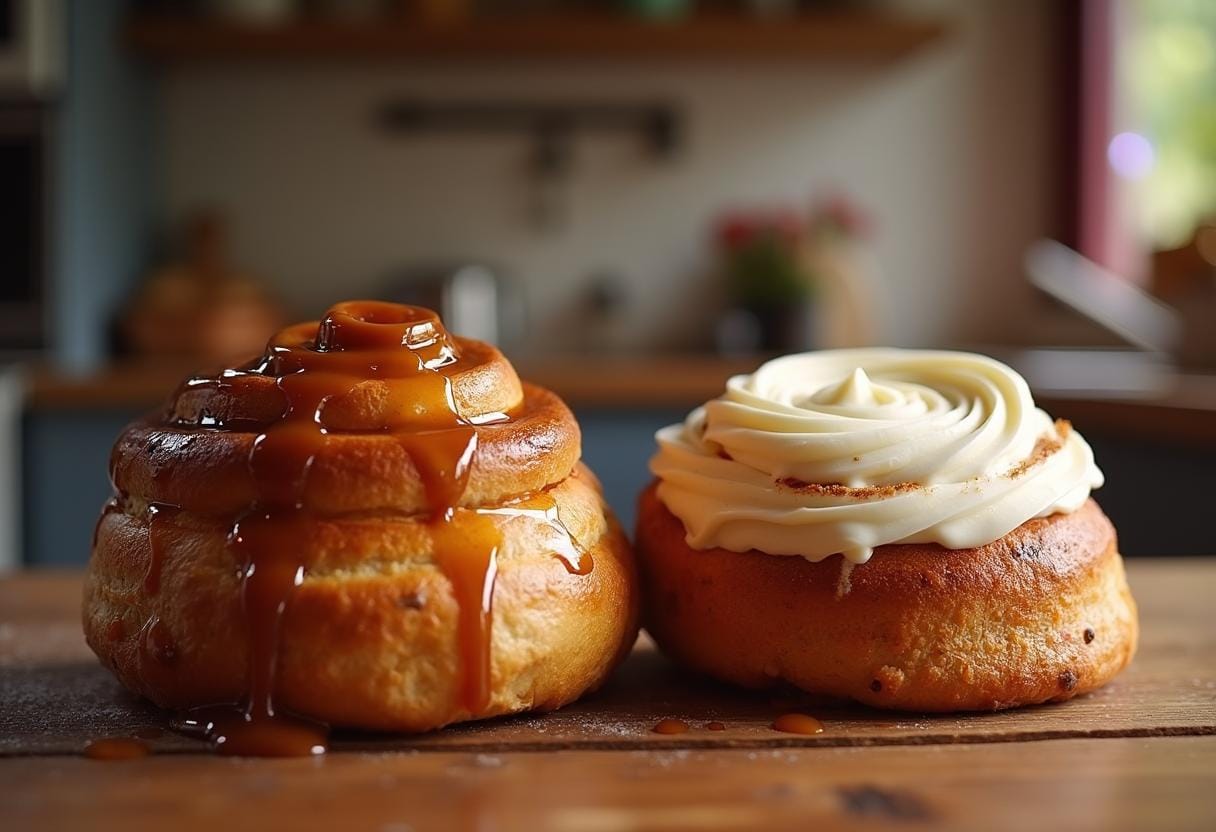What is the difference between cinnamon bun and cinnamon roll? At first glance, these pastries might look similar, but the difference between cinnamon bun and cinnamon roll lies in their unique flavors, textures, and preparation methods. Whether you enjoy the sticky caramel topping of a cinnamon bun or the soft, frosted layers of a cinnamon roll, understanding the difference between cinnamon bun and cinnamon roll will help you appreciate these sweet delights even more. Let’s dive deeper into this delicious debate!
Introduction to Cinnamon Delights
The difference between cinnamon bun and cinnamon roll is more than just a matter of names—they’re distinct in flavor, texture, and preparation. Both are beloved cinnamon-filled pastries, but their unique traits make them special in their own way. Let’s explore what sets these sweet treats apart and uncover why each has its own fan base!
If you’ve ever wondered whether you’re biting into a cinnamon bun or a cinnamon roll—or even if it really matters—you’re in the right place. Let’s dive in and uncover what sets these two apart.
What Are Cinnamon Buns? Exploring the Difference Between Cinnamon Bun and Cinnamon Roll
Origins of Cinnamon Buns: A Key Factor in the Difference Between Cinnamon Bun and Cinnamon Roll
Cinnamon buns are believed to have originated in Northern Europe, particularly in Sweden. Known as « kanelbullar, » they are a staple of the Swedish « fika, » a tradition of enjoying coffee with a sweet snack. If you’re interested in more Scandinavian baking traditions, check out Apple Cinnamon Brioche Rolls, which share some similarities with cinnamon buns.ck out this detailed article.
Historically, cinnamon was once a rare and expensive spice, reserved for royalty or special occasions. Over time, its availability spread, and so did the love for cinnamon-laden baked goods.
Key Ingredients That Define the Difference Between Cinnamon Bun and Cinnamon Roll
Cinnamon buns are made with a yeast-based dough that’s enriched with butter, milk, and eggs. The filling consists of a sweet mixture of cinnamon, sugar, and more butter, which is generously spread over the rolled-out dough before it’s shaped.
To enhance the flavor, some bakers add nuts, raisins, or even cardamom to the filling. After baking, cinnamon buns are often topped with a glaze, powdered sugar, or a simple cream cheese frosting.
| Ingredient | Quantity |
|---|---|
| All-purpose flour | 3 cups |
| Active dry yeast | 2 1/4 tsp |
| Milk | 1 cup (warm) |
| Butter | 1/4 cup (melted) |
| Sugar | 1/3 cup |
| Cinnamon | 2 tbsp |
Unique Preparation Techniques: How Cinnamon Buns Differ from Cinnamon Rolls
Cinnamon buns are all about texture. The dough is kneaded until soft and elastic, then rolled out into a thin rectangle. The cinnamon-sugar filling is spread evenly, and the dough is rolled into a log. It’s then sliced into individual buns and arranged on a baking tray, often with a bit of space between each piece to give them room to rise.
Here’s the twist: some recipes include a caramel or syrup layer at the bottom of the pan, which creates a sticky, gooey topping when the buns are inverted after baking. Yum!
« Cinnamon buns are like a warm hug—they’re comforting, sweet, and just a little sticky! »

What Are Cinnamon Rolls? Understanding the Difference Between Cinnamon Bun and Cinnamon Roll
Historical Roots of Cinnamon Rolls and Their Difference From Cinnamon Buns
Cinnamon rolls, while similar to buns, are especially beloved in the United States. They’re thought to have been inspired by their European cousins but have taken on their own identity over time. In the U.S., they’re a classic breakfast staple, often served in cafes or bakeries.
Unlike buns, cinnamon rolls are usually baked together in a single pan, creating soft edges where the rolls touch.
Ingredients That Highlight the Cinnamon Bun vs. Cinnamon Roll Debate
The base ingredients for cinnamon buns and cinnamon rolls are quite similar: a yeast-based dough enriched with butter, milk, and eggs, a cinnamon-sugar filling, and sometimes a sweet glaze.
American-style cinnamon rolls are typically slathered with rich cream cheese frosting, which melts slightly when applied to the warm rolls.
Baking Techniques: Another Key Difference Between Cinnamon Bun and Cinnamon Roll
The preparation of cinnamon rolls involves rolling the dough tightly after spreading the cinnamon-sugar filling, just like buns. However, they are often arranged closely together in a baking dish, so they rise and bake as a cohesive pull-apart treat.
One notable difference? The frosting. Cinnamon rolls are practically synonymous with a thick layer of creamy icing, which adds sweetness and a delightful contrast to the spiced filling.
Comparing Cinnamon Buns and Cinnamon Rolls: Key Differences
At this point, you might be thinking, « Okay, they sound pretty similar. » And you’re right—they do share many common traits. However, the devil is in the details!
Ingredient Variations That Show the Difference Between Cinnamon Bun and Cinnamon Roll
While both pastries share a base dough and filling, the toppings often set them apart. Cinnamon buns lean toward simpler glazes or caramelized toppings, while cinnamon rolls go all-in with heavy frosting. For a comparison between enriched dough varieties, explore the Brioche Bun vs. Regular Bun guide to understand how different pastries vary in texture and taste.

Preparation Methods and the Cinnamon Bun vs. Cinnamon Roll Distinction
Cinnamon buns are typically baked individually, allowing each piece to have distinct edges. Cinnamon rolls, on the other hand, are baked together, creating a softer texture where the rolls touch.
Shape and Presentation: Visual Differences Between Cinnamon Bun and Cinnamon Roll
Cinnamon buns often have a more freeform shape, especially when baked with caramel on the bottom. Rolls maintain their spiral form, making them look tidy and uniform.
« Think of cinnamon buns as the rustic artist and cinnamon rolls as the polished designer. Both are beautiful in their own way! »
Before diving into their differences, it’s worth noting the similarities between cinnamon buns and cinnamon rolls. After all, they’re like siblings—sharing a common ancestry but with distinct personalities.
Both buns and rolls rely on enriched dough, which includes milk, eggs, and butter. These ingredients give the pastries their soft, tender crumb. The cinnamon-sugar filling is another universal component, providing that signature spiced sweetness that we all know and love.
Common Serving Styles
Whether you’re enjoying a cinnamon bun or a roll, both pair wonderfully with a cup of coffee or tea. They’re popular for breakfast, brunch, or as a mid-afternoon snack. Some people even eat them as a dessert after dinner.
« Regardless of whether it’s a bun or a roll, one thing’s for sure—they’re best served fresh and warm, straight out of the oven! »
Regional Variations That Highlight the Difference Between Cinnamon Bun and Cinnamon Roll
Did you know that cinnamon pastries have many regional cousins? Different countries have put their own twist on these treats, highlighting local flavors and traditions.
In Scandinavian countries, a close variation of cinnamon buns is the « kanelsnurrer. » These are twisted cinnamon pastries, often flavored with cardamom and sprinkled with pearl sugar.
American Sticky Buns: A Unique Take on the Cinnamon Pastry Debate
Sticky buns are a popular variation in the United States. These are essentially cinnamon buns baked with a caramel sauce and sometimes topped with chopped nuts. The result? A gooey, sticky delight that’s almost impossible to resist.
European Pastries and the Cinnamon Bun vs. Cinnamon Roll Twist
In parts of Europe, cinnamon pastries often take the form of simpler rolls or twists, sometimes with a dusting of powdered sugar. While the emphasis remains on the cinnamon, they’re generally less sweet than their American counterparts.
Nutritional Differences Between Cinnamon Bun and Cinnamon Roll
As delicious as these treats are, they’re definitely indulgent. But is one “healthier” than the other? Let’s take a closer look at their nutritional profiles.
| Nutritional Component | Cinnamon Bun | Cinnamon Roll |
|---|---|---|
| Calories | ~300-350 per bun | ~400-450 per roll |
| Sugar | ~12-15g | ~20-25g |
| Fat | ~8-10g | ~12-15g |
Calorie and Sugar Content: How Cinnamon Buns and Rolls Differ
Cinnamon rolls tend to have higher calorie counts, primarily due to the heavy frosting that’s slathered on top.
Fat Content: A Nutritional Perspective on the Cinnamon Bun vs. Cinnamon Roll Debate
While both treats contain sugar and butter in their dough and filling, the caramel topping on buns or the icing on rolls can significantly add to their sugar and fat content.
« If you’re counting calories, you might want to save these pastries for a special treat—but hey, life’s too short to skip dessert! »
Common Issues in Baking Cinnamon Buns and Rolls
If you’ve ever tried baking cinnamon buns or rolls at home, you know it’s not always smooth sailing. Here are some common problems and how to fix them.
Why Do Cinnamon Pastries Turn Out Dry?
Dry cinnamon buns or rolls often result from overbaking. The solution? Keep an eye on your oven and test for doneness by touching the tops—they should feel soft but not doughy.
Troubleshooting Undercooked Centers
Nobody likes a raw, doughy center. To avoid this, ensure you roll the dough evenly and don’t overcrowd the pan. You can also bake at a slightly lower temperature to allow the centers to cook thoroughly without overbrowning the edges.
« Baking is a science, but it’s also an art—practice makes perfect! »
Tips for Making the Perfect Cinnamon Bun or Roll
Want to bake cinnamon pastries that rival those from a bakery? Here are some tips to help you achieve perfection.
Choosing the Right Dough Recipe
Look for a dough recipe that includes plenty of butter and milk for richness. If you want extra fluffiness, let the dough rise twice—once after mixing and again after shaping.
Best Practices for Rolling and Filling
When rolling out the dough, aim for an even thickness of about 1/4 inch. Spread the filling generously but leave a small border along the edges to prevent it from spilling out.
Serving Suggestions and Pairings
Cinnamon buns and rolls are versatile treats that pair beautifully with a variety of toppings and drinks.
Classic Glazes and Toppings
For cinnamon buns, consider a simple glaze made from powdered sugar, milk, and vanilla extract. Cinnamon rolls shine with cream cheese frosting or even a drizzle of maple syrup.
Beverage Pairings
Pair your cinnamon pastry with a hot cup of coffee, a latte, or even a spiced chai tea. For something colder, a glass of milk is always a winner.
« There’s no wrong way to enjoy a cinnamon bun or roll—just go with whatever makes your taste buds happy! »
Cinnamon Buns vs. Rolls: Which One to Choose?
When it comes to choosing between cinnamon buns and cinnamon rolls, it often boils down to personal preference and occasion.
Occasion-Based Recommendations
If you’re hosting a brunch, cinnamon rolls with their gooey frosting are a showstopper. For a more rustic gathering, cinnamon buns with a caramel topping add a homemade charm.
Personal Preferences and Flavor Profiles
Do you prefer your pastry on the sweeter side? Go for a cinnamon roll. Want something a bit less sugary but still delicious? A cinnamon bun might be your best bet.
Conclusion
So, what’s the verdict? Both cinnamon buns and cinnamon rolls are undeniably delicious, each with their own unique traits. Whether you’re a fan of the gooey frosting on a roll or the caramelized goodness of a bun, there’s no wrong choice.
At the end of the day, these pastries aren’t just about flavor—they’re about comfort, tradition, and the joy of sharing something sweet with the people you love.
« Why choose between a cinnamon bun and a cinnamon roll when you can enjoy both? »
FAQs About Cinnamon Buns and Rolls
How long do cinnamon buns and rolls stay fresh?
Cinnamon buns and rolls are best enjoyed fresh but can last 2–3 days at room temperature if stored in an airtight container.
Can I freeze cinnamon buns or rolls?
Yes! Freeze them before adding the glaze or frosting for the best results.
Why is my dough not rising?
Your yeast might be expired, or the liquid you used could have been too hot or too cold.
What’s the best way to reheat cinnamon buns or rolls?
Pop them in the microwave for 20 seconds or warm them in the oven at 300°F for a few minutes.
Are there vegan versions of cinnamon buns and rolls?
Absolutely! Use plant-based milk, butter, and cream cheese alternatives to make them vegan-friendly.
What’s the secret to soft and fluffy cinnamon pastries?
Let the dough rise properly and avoid overbaking. Also, don’t skimp on the butter—it makes a huge difference!

